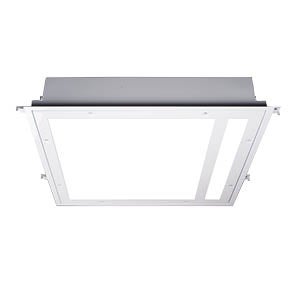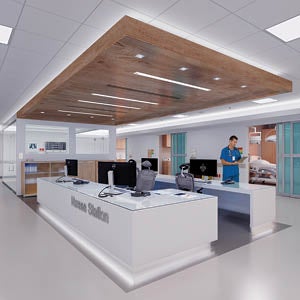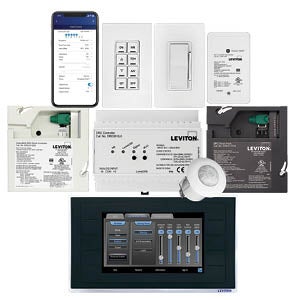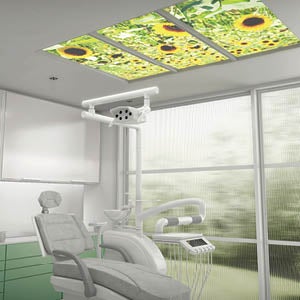Lighting manufacturers address hospital needs

Image courtesy of Acuity Brands
Advances in lighting fixtures and controls cover many areas that can benefit hospitals and other health care facilities.
For example, manufacturers see a growing trend toward sealed and cleanable fixtures as well as reduced dependence on wall-mounted fixtures in patient care areas.
There also is a lot of interest in light-based, continuous disinfection technology as well as touchless controls. Another major design trend is toward architectural aesthetics: lighting fixtures with clean lines that are less bulky and can almost disappear into a space.
Internet of Things (IoT) controllability, which can add wireless and touchless control to virtually any dimming fixture or on/off device, represents another trend. It allows hospital staff to control lights locally with an app or a computer dashboard from a central location.
Another trend is toward smaller lighting form factors being used in hospitals, according to Lou Calvo, regional sales manager at Kenall Manufacturing, Kenosha, Wis. “Additionally, the use of lighting controls is a must. They give patients and staff the opportunity to adjust lighting as needed. With LED now considered the standard, energy efficiency has become the expected norm.”
Energy and more
In fact, energy efficiency has been and will remain a driving factor for lighting fixtures and controls in health care spaces. “Energy efficiency is important throughout hospitals,” says Christian Groom, senior product marketing manager at Legrand, Carlsbad, Calif. “This includes scheduling (after-hours settings), occupancy or vacancy sensing, and automated shading systems to maximize ambient lighting usage.”
Many hospitals are adding occupancy sensors that dim light levels to save energy when areas are unoccupied. Also, there has been a lot of interest in occupancy controls for outdoor lighting and parking garages. “Some of the campuses we work with are large,” says Deepak Kumar Gedela, lighting controls specialist at Ledvance, Wilmington, Mass. “In addition to the energy savings, security patrols appreciate the security alerts that motion sensors provide.”
New LED luminaires are more energy-efficient than their predecessors due to high-efficacy LED light sources, combined with optical and electronic component efficiency. “They offer longer life for easier maintenance cycles and are intuitively designed to interface with various control platforms,” says Patricia Rizzo, health care and wellness programs manager at LaSalle, Quebec-based BalancedCare by Axis Lighting. “Even spectrally tunable systems, when programmed to maximize circadian effect at specific times of day, can save energy over traditional systems.”
Luminaire-level lighting controls (LLLCs) are the fastest-growing control option in indoor lighting and are now gaining momentum in health care, especially for small- to mid-size buildings such as outpatient clinics, according to Martin Mercier, strategic marketing manager for IoT and connected systems at Cooper Lighting Solutions, Peachtree City, Ga. “While health care facilities, especially large hospitals, have not widely adopted wireless lighting control, LLLC benefits are getting more attention.” LLLC luminaires are independent from other luminaires. They can be controlled individually or programmed as a group.
More hospitals are integrating lighting controls with information technology (IT) systems that allow smart luminaires to share information via the internet. IoT links the lighting to other systems, such as hospital security cameras, elevators and ID badges. “These smart luminaires share information on their operational status, efficiencies and LED energy use, and notify facilities managers about end of life — for example, when it’s time to change out components,” Rizzo says.
New research suggests that light exposure can offer major health benefits. This includes both visible and non-visible light frequencies. “Our ability to manipulate light frequencies and intensity across the entire spectrum through LED chip design and targeted control technologies allows us to design products in concert with the research and quickly bring new solutions to the market,” says Greg Galluccio, senior vice president of product management and engineering at Energy Focus Inc., Solon, Ohio.
Smaller, off-campus health care facilities tend to have limited budgets when it comes to lighting renovations and updates. Therefore, the default strategy is to opt for standalone controls, which are more functional. However, this limits the ability of the central office to remotely monitor and manage lighting assets.
“This forces satellite facilities to invest in local electricians and maintenance staff and opt for a siloed approach, which can result in a mix of control platforms that can become outdated,” says Rahul Shira, senior product marketing manager at Signify, Bridgewater, N.J.
“Newer technologies, such as the Interact Pro scalable system, make it possible to set up lighting controls in a standalone mode, so they don’t cause too much disruption for smaller facilities; yet they can tap into the benefits of connected systems,” Shira explains. “For example, they can interface with the central office to allow for remote monitoring and maintenance.”
When it comes to specifying and installing lighting fixtures and controls, hospitals pose some challenges to manufacturers. “Many applications require technical expertise to determine the appropriate luminaires and controls because of the critical nature of the work being done in hospitals,” Calvo says. “One example is surgical suites, which require high illumination levels and sophisticated controls. It’s also important that all components work cohesively.”
Regarding IoT, the health care sector has its challenges and opportunities, according to Gedela. “Rolling out a new building management system or networked lighting controls can be a tough sell due to the high level of collaboration that is required between facilities managers, IT and hospital administration. Automation and lighting controls also must work in harmony with backup power sources when line voltage drops out.”
Something new
New lighting fixtures and controls offer many of the aforementioned benefits to health care facilities. Viscor, a Leviton lighting brand based in Toronto has introduced the Certolux MSUi-DFX luminaire featuring 365DisInFx UVA technology, which is designed to promote cleaner surgical suites. “This surgical lighting fixture with continuous UVA disinfection technology reduces surface bacteria in occupied operating rooms and is suitable for 24-hour human exposure,” says Tim Stevens, director of product management at Certolux.
As a step away from traditional bulky troffers, Healthcare Lighting, a part of Acuity Brands, Atlanta, has introduced the HPL series, a recessed linear lighting solution that delivers single- and multi-modal functionality for patient rooms, hallways, common areas, and exam or procedure rooms. The multiple modes of lighting allow users to easily switch between exam, ambient and reading modes. “Asymmetric distribution is available for offset mounting in hallways to reduce direct lighting into patients’ eyes,” says Cleveland Blankenship, business unit leader. The HPL series has IP64 and NSF2 ratings as well as secondary color options for other specialty application areas.
Expanding on its Balanced Care line of luminaires, Axis Lighting recently launched the Tranquility series, a line of graphic image luminaires that address the biophilic element to provide a sense of calm by bringing the outdoors inside. Photography and custom-textured patterns integrate into ceiling mounts and sconces for use throughout hospitals — from waiting areas to nurse stations, from conference rooms to dental exam rooms. “We’ve also added a series dedicated to pediatric environments, which includes waiting rooms, newborn intensive care units, daycare centers and classrooms,” Rizzo says.
David Buerer, director of product management at Leviton, Melville, N.Y., says his company has made advances in color tuning. “One recent solution we deployed involves color tuning to support improved surgical recovery. It is based on research that says patients recover more quickly from surgery when they come out of a sedated state in the morning. Our controls system, in concert with color tuning light fixtures, allows the nurse to start the day cycle as the patient is waking up and maintain it throughout the patient’s stay.”
Signify recently introduced the Ledalite NatureConnect natural lighting system, which is designed to reconnect patients to the outside world — specifically, the constant cycles and variations of nature — creating a comfortable, engaging indoor environment. The system combines various LED luminaires with intuitive lighting controls for a fully immersive, natural experience, according to Shira.
“The NatureConnect system can be used to improve patient and staff well-being with its natural ‘day rhythm’ functionality,” Shira says. “It automatically provides the right light according to the time of the day, following the pattern of the sun.” An intuitive user interface makes it easy for patients and staff to control the lighting; users can switch between the automatic day rhythm or choose one of three natural light scenes that may be better suited to the user’s activity or need.
Scalable systems
Cooper Lighting Solutions recently introduced lighting control options for its WaveLinx wireless system, WaveLinx Lite, and a new app for its Trellix platform, Trellix Insights. “The WaveLinx scalable system can be upgraded from Lite to Pro, making it suitable for everything from a single floor to an entire campus,” Mercier says. “It can be connected to Cooper Lighting Solutions’ IoT platform, Trellix, which provides further building insights and remote management.”
Trellix Insights is an intuitive, web-based tool that leverages data collected by the lighting system, which provides instant visibility and reports for space optimization. By gathering space information, Trellix Insights helps facilities managers make accurate forecasts and avoid unnecessary expansion or reduction. Also, under its Fail-Safe brand, Cooper Lighting Solutions recently improved its tunable white light offering and added UVC-related products.
Energy Focus offers the EnFocus lighting control system, which can manipulate the light spectra within a wide range of areas in health care facilities. Unlike wireless control systems that incorporate transmitters and receivers in controls and light sources, the EnFocus system uses power line control technology to send control signals across existing supply wires, which reduces cost and improves reliability and security, according to Galluccio.
Inspired by its MedMaster MPH patient room headwall luminaire series, Kenall Manufacturing has introduced the MedMaster BHH headwall, which is designed to meet the unique demands of behavioral and mental health environments. “The BHH offers a sleek style, multiple functions and the safety features paramount to patient care, including ligature-resistant design, tamper-resistant hardware and polycarbonate lenses,” says Lynn Walldorf, product marketing manager. Options include a built-in 2,700 Kelvin (K) or amber nightlight, battery backup and a low-voltage controller.
Efficient lighting in hospital stairwells also is important. To that end, Sylvania UltraLED Ultrasonic Stairwell Fixtures from Ledvance employ an ultrasonic sensor to detect motion where line of sight is not feasible. Featuring both color changing technology (CCT) and lumen selectivity, the fixtures are available in 2-foot and 4-foot lengths with 3,500 K, 4,000 K or 5,000 K CCT output. They can be surface-mounted and are available with optional battery backup units.
Legrand recently introduced DLM shading systems, which feature automated and motorized shades that seamlessly integrate with lighting fixtures and controls. “They offer an experience that many designers and architects are looking for today while providing premium occupant comfort and experience,” Groom says. Wiring is simple, he adds, with preconfigured CAT 5 for connecting shade controllers and switches, and preconfigured four-wire connections for each shade and shade bus.
Looking ahead
In the near future, LED technology will continue to improve efficiency, manufacturers agree, and more lighting products will incorporate UVC disinfection features. Another prediction is increased adoption of IoT-related solutions such as asset tracking, location-based services and energy optimization through data analytics tailored to the facilities manager.

PLEASANT SURROUNDINGS
Ledalite NatureConnect Natural lighting system creates a pleasant environment for patients and health care workers. Signify

CLEAN OPERATOR
The MSUi-DFX is a recessed surgical luminaire with UVA disinfection technology that continuously reduces bacteria within the operating room. Viscor, a Leviton Company

MULTIFUNCTIONAL
The HPL Series offers exam, ambient, reading or night light functions within the same luminaire. Acuity Brands

LOST AND FOUND
Trellix locate software application is a real-time location system that allows facilities managers to manage and locate their assets within the facility by leveraging their WaveLinx Pro-enabled lighting system. Cooper Lighting Solutions

STEP LIGHTLY
The Sylvania UltraLED ultrasonic stairwell fixture features color-changing technology and lumen selectability. Ledvance

RELAXING RHYTHMS
The EnFocus control delivers healthy circadian lighting functionality over existing wire lines for simple, secure, healthy light. Energy Focus Inc.

COOL SHADES
DLM shading systems feature automated/motorized shades that seamlessly integrate with lighting fixtures and controls. Legrand

SAFETY FIRST
The MedMaster MRIGT series is constructed with non-ferrous materials and remote power supplies to prevent interference with magnetic resonance imaging equipment. Kenall Manufacturing

COMPLETE CONTROL
GreenMAX DRC wired and wireless solutions help promote well-being in health care environments. Leviton
Neal Lorenzi is a Mundelein, Ill.-based contributor to Health Facilities Management.





